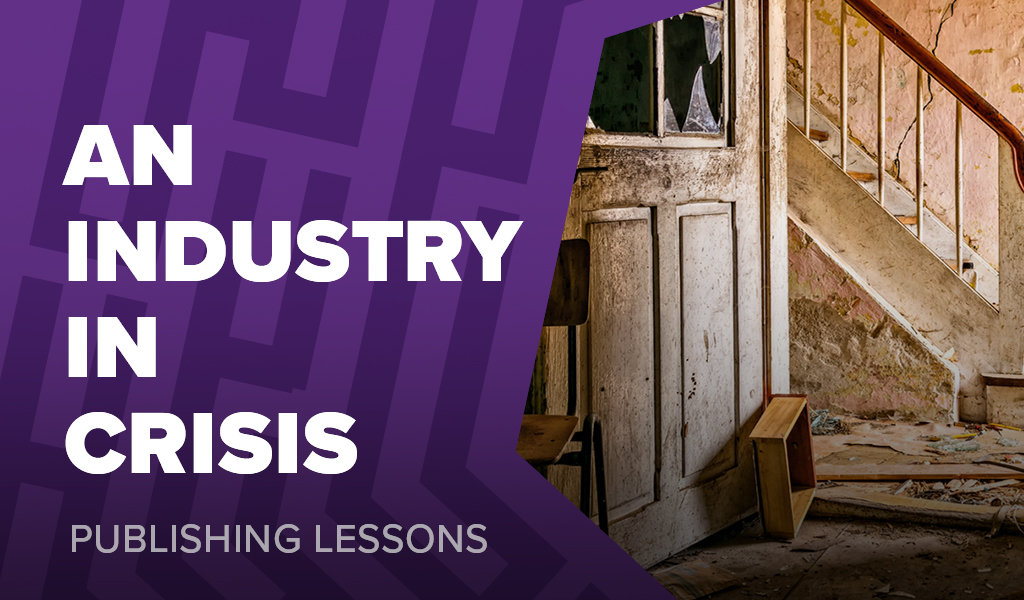An industry in crisis: What can we do?

I love making games.
I get up in the morning, head to my table, grab a pen and a piece of paper, and start scribbling ideas. I reach for the scissors and begin cutting, and before I know it, I have the beginnings of a game. A creation from my mind becomes something real—something fun to engage with.
But I didn’t just choose to be a game designer. I chose to be a game publisher. And that, as much as I hate to say it, means I run a business.
Running a business is challenging, and in recent years, those challenges have only gotten harder.
Some of the difficulties I’ve faced were my own fault—things I might have avoided. Others were just bad luck. Here are a few that come to mind.
Setbacks Along the Way
In 2018, my very first print run arrived from China. We opened the containers, only to find the games had collapsed during shipping. Around 20% of the entire print run was damaged. It was heartbreaking. What should have been a moment of celebration became a disaster.
But I learned. I adapted. I made sure future games were better packed, stronger, and more secure.
Then came COVID.
It was the time of my biggest crowdfunding campaign ever. And yet, thanks to the global shipping crisis, container costs skyrocketed—from $3-4,000 to $25-30,000 per container. That’s over six times higher. I was shipping multiple containers, and the extra costs ran into the hundreds of thousands of dollars.
Soon after, Russia invaded Ukraine. I made the decision to stop working with my Russian partner. At the time, Russia was my third-largest partner and second-biggest translation market. That decision meant thousands of games weren’t produced, and a major revenue stream was lost overnight.
And now?
We’re facing new tariffs from the US on Chinese imports, announced just last night. These tariffs have risen to 54%, meaning I now need to pay over half the value of every product I send to the US. It’s an enormous increase, and frankly, the most immediate and damaging blow yet.
The Tipping Point
All these things—shipping crises, war, and now tariffs—have real consequences. I expect some businesses will close. Some creators will raise prices. Others are probably sitting at home right now, wondering:
What can I do?
Raising prices is the only obvious solution. But if we raise prices, will people still buy our games? Will print runs shrink? Will margins disappear? Will the industry collapse?
I understand these fears. But we’ve been through hard times before. And while we can’t ignore what’s happening, we can adjust.
I can’t change the tariffs. I can’t make them go away.
But I can make a decision for myself—about how to move forward.
I didn’t sign up to be just a game designer. I chose to be a publisher, and that means making tough choices. It means finding a way through.
What Can We Do?
That depends on who you are.
If you’re a hobbyist or fan:
You can help. Support your favourite publishers. Buy games directly from their stores or local retailers. That extra support can make a real difference.
Be prepared for price increases and understand they’re often outside of a publisher’s control. But also be mindful—don’t let companies take advantage of the situation. Honesty and transparency are key. Working together matters.
If you’re a publisher:
Take a moment. Reflect. Decide how to move forward.
Can you absorb the costs? If not, you might have to raise prices or ask for more money. Plan for the future, because these tariffs could disappear next week—or they could be here for years.
You may need to think seriously about direct sales or crowdfunding. These channels give you far more control over pricing, margins, and communication with your audience—making it easier to account for rising costs than the rigid structure of traditional retail and distribution. If the model can’t change, then our approach must.
For my upcoming Kickstarters, I’ll need to factor these tariffs into my pricing. It’s just the reality now.
Rethinking the Model
Perhaps this is a time to rethink the traditional distribution model.
With the current model if I have a $50 game, it likely costs me $10. My distributor pays me $20, the retailer pays them $30, and they sell it to the end customer who pays $50. Everyone gets a consistent cut in the “5 times multipliers model”.
Now my production cost has risen to $15. If I multiply that by 5, the game MSRP goes up to $75. My distributor pays me $30, the retailer pays them $45 and the end customer pays $75.
The same game now costs 50% more. Everyone is making a little more money as well, but a relatively small change has had a major impact.
But what if we changed the way we handled unexpected fees like tariffs?
Instead, what if we added a flat fee? Keep the base price at $50 and add the $5 tariff cost across the board—publisher, distributor, retailer, and customer. Everyone shares the burden. The final cost to the customer? $55, not $75.
It’s not perfect. Controlling what should be in the multiplier vs the fixed fee is difficult and perhaps requires too much trust. But maybe it’s time we stop relying on 20-year-old models and start building something that works in today’s climate. To survive, we need to adapt and think outside the box—because these are the things we, as an industry, can still control.
Because tariffs, wars, and shipping crises aren’t going away.
Relativity Matters
It’s easy to get overwhelmed by the big numbers. But numbers are relative.
If one publisher is hit with a $2,000 bill and another with a $200,000 bill, both are valid struggles. The scale may differ, but the impact is personal and proportionate.
For example: If I sell 1,000 games and owe $5,000 in tariffs, and someone else sells 100,000 games and owes $500,000, we’re both paying $5 per game. In fact, my costs may hurt more—because I won’t benefit from the same volume discounts on production.
I say this not to disvalue anyone’s challenge, but because I’ve already started seeing people throwing big numbers around. It’s important we don’t diminish the smaller publishers who are equally affected.
For the record, I’m looking at a minimum of $60,000 that will be due in a couple of weeks thanks to this week’s announcement. And it’s daunting. But it’s no more meaningful than the $2,000 bill another publisher is facing, if their print run is many times smaller.
Final Thoughts
To everyone going through this—I’m sorry. Truly.
But we’ve already lived through three or four major disruptions in the past few years. I wouldn’t be surprised if more are coming.
You must plan for the unknown.
When I launched Emberleaf on Kickstarter last year, I was aware of what might happen and I considered the world’s shifting landscape when finalising the prices. I never predicted a 54% tariff—but I did expect something, and that mindset helped.
We need to stay smart. Stay flexible. Stand up when we can, and adapt when we must.
Because if we don’t evolve, we’ll be left behind.
If you’re going through this and want someone to talk to, feel free to leave a comment or drop me an email—you’ll find it in the contact section above. I’d love to hear your thoughts, and how you’re approaching these new challenges.
Frank West
Frank West is a gamer and designer based in Bristol, UK. He published his first board game, The City of Kings, in 2018 and now works on other games and organising events in the local area. His goal? To design and publish games focusing on immersive themes, fun mechanics and beautiful components. If you have any questions or would just like a chat, feel free to get in touch at any time!


9 comments
Gerald Fitzsimons
3rd April 2025 at 4:16 pm
With your Rethinking the Model idea with a x5 multiplier, do you think this could work?
In this scenario the game now costs $15 instead of $10 to manufacturer. You used to make $10 profit per game. What if you set the MSRP at $65 instead of $75? This means the distributor pays you 40% of the MSRP as normal, which is $26. That is $26 – $15 = $11. You make $1 profit more than before the tariffs and the game is $10 cheaper than it would have been setting the MSRP with the old model.
Frank West
3rd April 2025 at 5:04 pm
Hey Gerald,
I think this approach is something some publishers will use—especially in the immediate future—to try and find a good balance. It works as a short-term middle ground, but I don’t think it’s the right long-term solution.
By increasing the MSRP by 30% and profit by 10%, you’re lowering margins overall. That’s likely to result in less total profit as sales drop, and the extra profit per unit doesn’t necessarily make up for the lost volume. More importantly though, many agreements and costs are based on the MSRP or sale price—so that extra dollar often disappears. For example, if you’re paying a 10% royalty, does that now include 10% of the extra $15? If so, you’re giving away another $1.50, immediately losing that $1 of extra profit.
I feel we need a long-term, maintainable, and flexible solution. Tariffs might drop or increase again tomorrow—potentially adding another $10 to the RRP—and every time that happens, everything needs to be recalculated and potentially renegotiated.
If we moved to a fixed cost + surcharge model (similar to how FedEx handles fuel surcharges), we’d gain much more freedom in these agreements. It would keep everyone profitable, avoid putting pressure on a single point in the supply chain, and help keep the end price as low as possible.
I’d certainly love to hear other options!
Gerald Fitzsimons
3rd April 2025 at 5:25 pm
That’s a good point. I didn’t factor in lost volume. I wonder though if the lost volume would be the same as if one company increased the price vs the entire industry increasing their price. If one petrol/gas station put up their prices by 50% the would lose a lot of volume, but if the entire industry put up the price (which is normal in that industry) then they would not see such a lose in volume or any lose in volume.
All though, that that example is the price of an essential item, I think the lose in volume for a board game company won’t be a big a lose if it was them alone increasing their prices. If someone wanted to buy a medium weight Euro and it was your game for $75 vs others for $50 that would be a big factor, but if they all cost $75 there is nothing extra to discourage them from choosing your game.
I like your idea, if just the tariff was added on at retail (like the sugar tax and plastic bottle tax in some parts of the world) that would be the ideal way to handle it.
Cassie Simpson
4th April 2025 at 12:40 am
That’s kind of what I was thinking of doing with our games – just pass the direct cost increase and keep everything else the same. I don’t like customers knowing our margin so much, but if it’s a given industry standard, I guess it’s not really a secret. We have nearly 40k as well, it’s a blow.
Frank West
4th April 2025 at 10:05 am
One thing I’ve learned over the years is that the more transparent I am, the more people are willing to support me when things get tough. We’re lucky to work in such a caring industry, and while I also prefer to keep exact margins private, I believe that, in situations like this, openness is one of the few tools we have to help us all get through it.
Scott Czysz
4th April 2025 at 1:03 am
I think your “Rethinking the Model” section makes a lot of sense. Similar to “fuel surcharges” that were added to UPS freight fees years ago.
Thank.
Frank West
4th April 2025 at 10:06 am
Absolutely, and if it can work for them, something similar should be able to work for us.
Stuart Tonge
6th April 2025 at 12:09 pm
Good article – thanks!
All of this thinking is a good idea. I don’t see anything like this line of thinking currently being tabled by any of my distributors – maybe they are having the same thoughts and need some time to think it through before anyone can propose anything. It is all moving fast and could change at the drop of a hat. Has anybody seen anything from their distributors musing on such things?
Frank West
7th April 2025 at 10:41 am
Thanks Stuart!
I haven’t seen these discussions taking place, though they may well be happening behind closed doors. The main concerns I see are:
– Is it worth investing time in changing the system if the tariffs might disappear tomorrow?
– How do we technically implement any changes, given the number of systems with hardcoded calculations?
– How do we communicate these changes to over 2,500 retailers and 1,000 publishers?
I’d like to think the first point isn’t a major blocker as it would be future proofing against any unexpected outcomes, but points two and three will definitely present some challenges. Hopefully someone is working through them!